Half-Life is one of the most influential games of all time, thanks not just to its immersive setting, story and visuals, but to its ‘modability’. Long after most people had played through Half-Life’s campaign, games and mods powered by the GoldSrc engine continued to entertain and amaze. Almost 25 years after its original release, a new mod for Half-Life has arrived: a fully ray-traced version of the game, courtesy of modder Sultim Tsyrendashiev – who previously produced ray-traced versions of Serious Sam, Doom and Quake.
The mod completely remakes the game’s lighting using path tracing while maintaining its assets, thereby providing an alternate vision of a modern Half-Life compared to, say, the popular fan remake Black Mesa. It’s a transformative upgrade that’s well worth experiencing, so we played through the RT version to break down what exactly the mod does, how it compares to the original 1998 release and see how well it performs on modern graphics cards.
Getting started is thankfully straightforward – just install Half-Life on Steam, then download the necessary files from Sultim’s Github page, following the instructions provided.
Interestingly, Half-Life RT is a fork of Xash3D rather than GoldSrc, an open-source 3D engine that maintains excellent compatibility with GoldSrc assets. The RT version builds on this by replacing the rendering portion with a Vulkan-driven path tracer. Nearly all the art, textures and models are the same; the key difference is primarily in how these objects are lit and shaded.
Looking back at the original Half-Life, it was designed with the CPU, GPU and RAM limits of the day in mind – so real-time lighting was minimal, limited to the game’s rarely-used flashlight. Most lighting was calculated offline and then projected onto the world with textures – normally in a static fashion but occasionally they were toggled on and off or swapped out rapidly to give the appearance of dynamic lighting. In general, the light maps show light emanating from the sun, lights and other logical light-producing sources, and even bounce lighting is scientifically considered to produce realistic results.
Valve’s attention to detail in nailing the consistency of their lighting means that the game still looks reasonable in 2023, but it also means that the game is almost uniquely suited to a path-traced conversion.
For the RT mod, Sultim ensured that lighting of the same style and intensity is emanating from the same light sources of the original game. That makes the path-traced lighting look incredibly faithful to the original – just with more detail and – more importantly – dynamism.
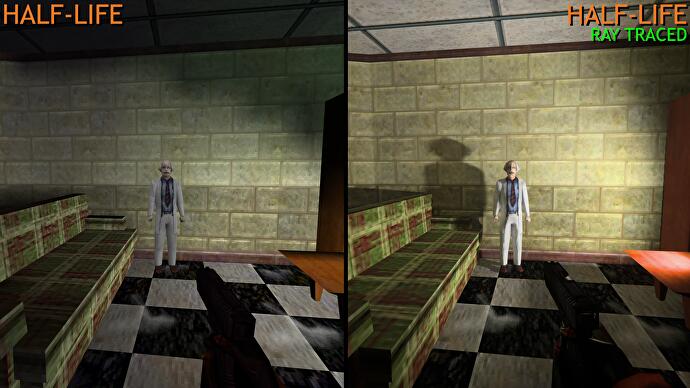
For example, the original game featured office lamps that produced coloured light on its surroundings as you’d expect, and in the RT remake you get nearly identical colouring and directionality, but now the lighting is per-pixel accurate and fully dynamic rather than being a low resolution static texture. If a scientist wanders in front of the lamp, they now get a matching shadow. There’s a similar but more dramatic effect with light issuing from behind spinning fan blades, which now cast a moving shadow into the room and onto themselves. In the original game, there was often a noticeable contrast between characters and their environments due to the differences between the lighting afforded to static and dynamic objects, but now both categories feel equally grounded in the game world.
Bounce lighting was present in the original game as mentioned earlier, but the numbers of objects included within it, and its overall quality, was limited by the realities of costly offline rendering at the time. That means the RT version dials bounce lighting up to 11, producing more realistic results, with light bouncing multiple times to propagate the scene. For example, this causes the blue colour of the sky to more obviously influence the colour of shadowed regions, and provides a more visually striking look with more obvious directionality to scenes that are strongly lit from a single source, eg rooms with skylights. As the directionality and intensity of global illumination effects are much more prounced, we also see changes in smaller indoor locations – even a small light on a wooden desk can colour a whole room with a red-brown hue if it’s the only light source in the area.
Emissive light sources are also beautifully handled here, with pools of toxic waste producing a terrifying ambient glow without the light leaking or weirdness with moving objects you’d spot in the original game. Sultim also uses these light sources to replace the rare instances of ‘fake’ lighting from the original game, lighting pipes with a pool of toxic sludge. I love how this fits the Half-Life theme, but still allows the physically-plausible path tracing to work its magic.
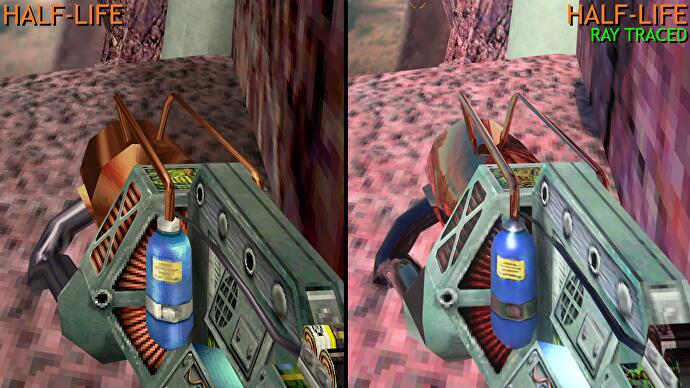
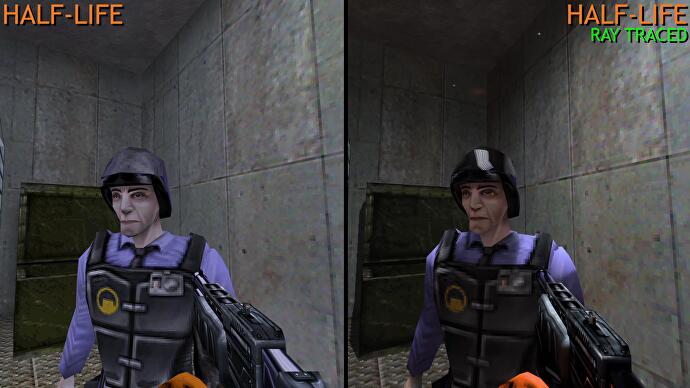
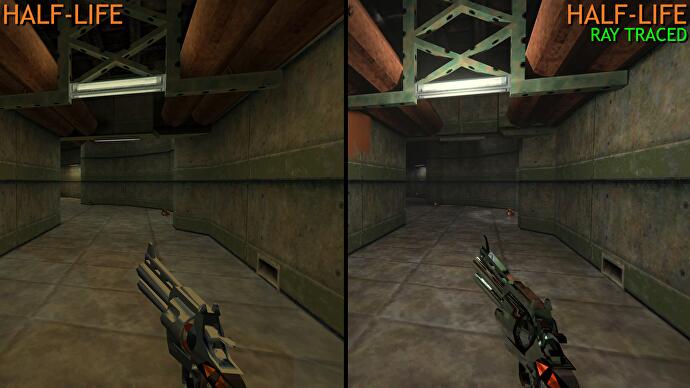
As well as recreating the lighting in real time with higher fidelity, the RT path tracer also adds reflections to objects that had shiny textures in the base game, such the Colt Python revolver, Gordon’s HEV suit or Barney’s helmet. Gordon’s iconic crowbar is significantly shinier too, and also more geometrically complex. There are also more subtle changes, such as the metal tips of shotgun shells being more reflective than the matte box they sit inside, or some first-person weapon models having their hand-drawn reflections replaced with physically accurate ones. Outside of metals, water and glass now produce realistic, perspective-correct reflections and refraction.
The Half-Life Ray Traced modf also adds lit fog, something that Half-Life’s contemporaries like Unreal used but Half-Life didn’t. For example, the light rays visible in the original train ride sequence use hand-placed transparent geometry. Now, the game uses a per-light ray-marched approach which produces obvious beams of light, which both replaces existing light rays and adds the technique to scenes that lacked it – often to dramatic effect. This is one of the more obvious artistic changes from the original and came as a pleasant surprise given how long it must have taken to add this in for each scene.
Finally, the path-traced renderer includes some subtle post-processing, such as bloom, which can be tweaked in the graphics options menu. It’s also possible to change more complex variables like sky intensity, water colour and volumetric lighting in the console or via an autoconfig file, so you can make the game look just how you prefer if the defaults don’t do it for you. You can even render the game using the classic lighting, which keeps all of the new reflections of the path-traced renderer but gets rid of all-new additions from the path traced lighting, volumetrics and more – so if don’t like the new additions, you can still play Half-Life with some benefits of modern RT.
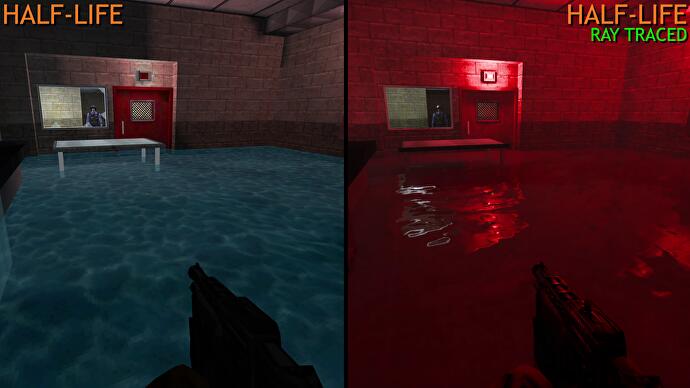
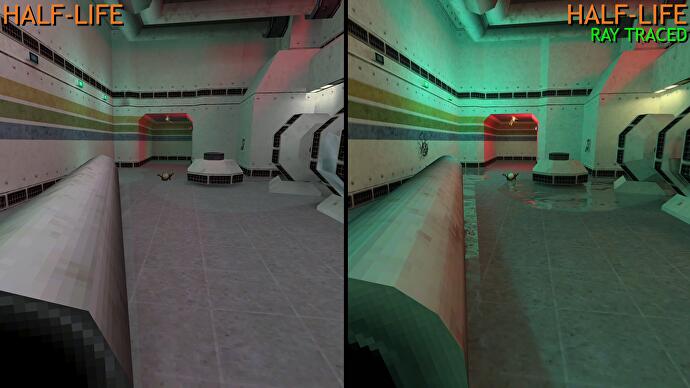
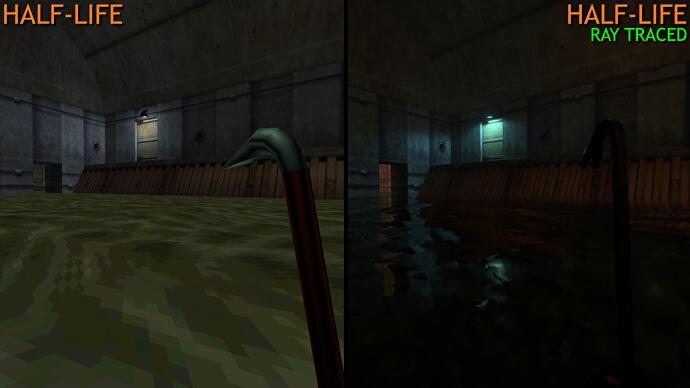
With regards to performance, FSR2 and DLSS are the only real ways to improve performance – this is just a mod and not a full game so there aren’t really any settings to tweak beyond these upscalers. By the way, I’d recommend not using the version of DLSS linked on the Github page, as it’s a ‘default’ version that seems to exhibit ghosting, and instead opt for the 2.5.1 version available at Techpowerup’s DLSS download page.
Nvidia GPUs have an advantage here in terms of frame-rate, due to their more advanced ray tracing hardware acceleration, with my testing showing an RX 6800 XT delivering around 60 percent of the performance of an RTX 3080. To target 4K 60fps on this level of hardware, you’ll need to use DLSS quality mode (Nvidia) or FSR2 Performance mode (AMD). For lower-end hardware, such as the RTX 2060, you can target 1080p60 using DLSS quality mode. Unfortunately for those of you with Intel hardware, the game doesn’t start with an Arc A770 installed at present.
Ray-traced Half-Life is a superb remix of the classic game’s visuals, with Sultim’s dedication and attention to detail shining through the entire mod. This release is a great excuse to play through the original game, and well worth checking out for anyone that picked up the title in a Valve Complete Pack back in the day.
